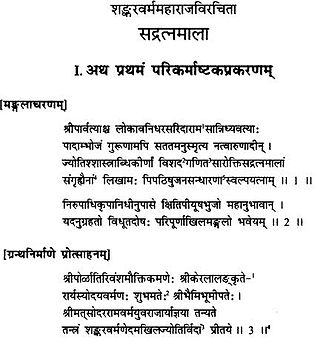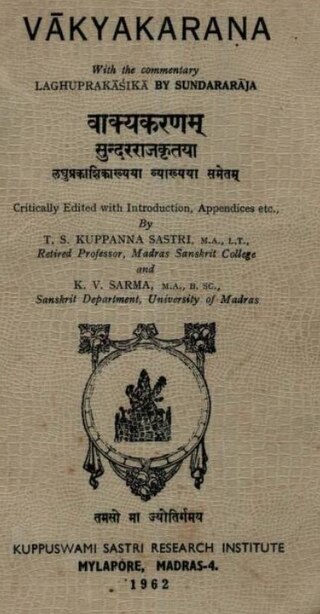
Astronomy is the oldest of the natural sciences, dating back to antiquity, with its origins in the religious, mythological, cosmological, calendrical, and astrological beliefs and practices of prehistory: vestiges of these are still found in astrology, a discipline long interwoven with public and governmental astronomy. It was not completely separated in Europe during the Copernican Revolution starting in 1543. In some cultures, astronomical data was used for astrological prognostication.

The Tychonic system is a model of the universe published by Tycho Brahe in the late 16th century, which combines what he saw as the mathematical benefits of the Copernican system with the philosophical and "physical" benefits of the Ptolemaic system. The model may have been inspired by Valentin Naboth and Paul Wittich, a Silesian mathematician and astronomer. A similar cosmological model was independently proposed in the Hindu astronomical treatise Tantrasamgraha by Nilakantha Somayaji of the Kerala school of astronomy and mathematics.

Aryabhata or Aryabhata I was the first of the major mathematician-astronomers from the classical age of Indian mathematics and Indian astronomy. His works include the Āryabhaṭīya and the Arya-siddhanta.
Keļallur Nīlakaṇṭha Somayāji, also referred to as Keļallur Comatiri, was a major mathematician and astronomer of the Kerala school of astronomy and mathematics. One of his most influential works was the comprehensive astronomical treatise Tantrasamgraha completed in 1501. He had also composed an elaborate commentary on Aryabhatiya called the Aryabhatiya Bhasya. In this Bhasya, Nilakantha had discussed infinite series expansions of trigonometric functions and problems of algebra and spherical geometry. Grahapariksakrama is a manual on making observations in astronomy based on instruments of the time.
Vatasseri Parameshvara Nambudiri was a major Indian mathematician and astronomer of the Kerala school of astronomy and mathematics founded by Madhava of Sangamagrama. He was also an astrologer. Parameshvara was a proponent of observational astronomy in medieval India and he himself had made a series of eclipse observations to verify the accuracy of the computational methods then in use. Based on his eclipse observations, Parameshvara proposed several corrections to the astronomical parameters which had been in use since the times of Aryabhata. The computational scheme based on the revised set of parameters has come to be known as the Drgganita or Drig system. Parameshvara was also a prolific writer on matters relating to astronomy. At least 25 manuscripts have been identified as being authored by Parameshvara.

Indian astronomy refers to astronomy practiced in the Indian subcontinent. It has a long history stretching from pre-historic to modern times. Some of the earliest roots of Indian astronomy can be dated to the period of Indus Valley civilisation or earlier. Astronomy later developed as a discipline of Vedanga, or one of the "auxiliary disciplines" associated with the study of the Vedas dating 1500 BCE or older. The oldest known text is the Vedanga Jyotisha, dated to 1400–1200 BCE.
Mādhava of Sangamagrāma (Mādhavan) was an Indian mathematician and astronomer who is considered as the founder of the Kerala school of astronomy and mathematics in the Late Middle Ages. Madhava made pioneering contributions to the study of infinite series, calculus, trigonometry, geometry, and algebra. He was the first to use infinite series approximations for a range of trigonometric functions, which has been called the "decisive step onward from the finite procedures of ancient mathematics to treat their limit-passage to infinity".
Jyeṣṭhadeva was an astronomer-mathematician of the Kerala school of astronomy and mathematics founded by Madhava of Sangamagrama. He is best known as the author of Yuktibhāṣā, a commentary in Malayalam of Tantrasamgraha by Nilakantha Somayaji (1444–1544). In Yuktibhāṣā, Jyeṣṭhadeva had given complete proofs and rationale of the statements in Tantrasamgraha. This was unusual for traditional Indian mathematicians of the time. The Yuktibhāṣā is now believed to contain the essential elements of calculus like Taylor and infinity series. Jyeṣṭhadeva also authored Drk-karana, a treatise on astronomical observations.
Achyuta Pisharodi was a Sanskrit grammarian, astrologer, astronomer and mathematician who studied under Jyeṣṭhadeva and was a member of Madhava of Sangamagrama's Kerala school of astronomy and mathematics. He is remembered mainly for his part in the composition of his student Melpathur Narayana Bhattathiri's devotional poem, Narayaneeyam.

The Kerala school of astronomy and mathematics or the Kerala school was a school of mathematics and astronomy founded by Madhava of Sangamagrama in Tirur, Malappuram, Kerala, India, which included among its members: Parameshvara, Neelakanta Somayaji, Jyeshtadeva, Achyuta Pisharati, Melpathur Narayana Bhattathiri and Achyuta Panikkar. The school flourished between the 14th and 16th centuries and its original discoveries seem to have ended with Narayana Bhattathiri (1559–1632). In attempting to solve astronomical problems, the Kerala school independently discovered a number of important mathematical concepts. Their most important results—series expansion for trigonometric functions—were described in Sanskrit verse in a book by Neelakanta called Tantrasangraha, and again in a commentary on this work, called Tantrasangraha-vakhya, of unknown authorship. The theorems were stated without proof, but proofs for the series for sine, cosine, and inverse tangent were provided a century later in the work Yuktibhasa, written in Malayalam, by Jyesthadeva, and also in a commentary on Tantrasangraha.

Aryabhatiya or Aryabhatiyam, a Sanskrit astronomical treatise, is the magnum opus and only known surviving work of the 5th century Indian mathematician Aryabhata. Philosopher of astronomy Roger Billard estimates that the book was composed around 510 CE based on historical references it mentions.

Yuktibhāṣā, also known as Gaṇita-yukti-bhāṣā and Gaṇitanyāyasaṅgraha, is a major treatise on mathematics and astronomy, written by the Indian astronomer Jyesthadeva of the Kerala school of mathematics around 1530. The treatise, written in Malayalam, is a consolidation of the discoveries by Madhava of Sangamagrama, Nilakantha Somayaji, Parameshvara, Jyeshtadeva, Achyuta Pisharati, and other astronomer-mathematicians of the Kerala school. It also exists in a Sanskrit version, with unclear author and date, composed as a rough translation of the Malayalam original.
Puthumana Somayaji (c.1660–1740) was a 17th-century astronomer-mathematician from Kerala, India. He was born into the Puthumana or Puthuvana family of Sivapuram. The most famous work attributed to Puthumana Somayaji is Karanapaddhati which is a comprehensive treatise on Astronomy.

Krishna Venkateswara Sarma (1919–2005) was an Indian historian of science, particularly the astronomy and mathematics of the Kerala school. He was responsible for bringing to light several of the achievements of the Kerala school. He was editor of the Vishveshvaranand Indological Research Series, and published the critical edition of several source works in Sanskrit, including the Aryabhatiya of Aryabhata. He was recognised as "the greatest authority on Kerala's astronomical tradition".

Sadratnamala is an astronomical-mathematical treatise in Sanskrit written by Sankara Varman, an astronomer-mathematician of the Kerala school of mathematics, in 1819. Even though the book has been written at a time when western mathematics and astronomy had been introduced in India, it is composed purely in the traditional style followed by the mathematicians of the Kerala school. Sankara Varman has also written a detailed commentary on the book in Malayalam.
Karanapaddhati is an astronomical treatise in Sanskrit attributed to Puthumana Somayaji, an astronomer-mathematician of the Kerala school of astronomy and mathematics. The period of composition of the work is uncertain. C.M. Whish, a civil servant of the East India Company, brought this work to the attention of European scholars for the first time in a paper published in 1834. The book is divided into ten chapters and is in the form of verses in Sanskrit. The sixth chapter contains series expansions for the value of the mathematical constant π, and expansions for the trigonometric sine, cosine and inverse tangent functions.
In astronomy, Jyotirmimamsa is a treatise on the methodology of astronomical studies authored by Nilakantha Somayaji (1444–1544) in around 1504 CE. Nilakantha somayaji was an important astronomer-mathematician of the Kerala school of astronomy and mathematics and was the author of the much celebrated astronomical work titled Tantrasamgraha. This book stresses the necessity and importance of astronomical observations to obtain correct parameters for computations and to develop more and more accurate theories. It even discounts the role of revealed wisdom and divine intuitions in studying astronomical phenomena. Jyotirmimamsa is sometimes cited as proof to establish that modern methodologies of scientific investigations were known to ancient and medieval Indians. Neelkantha Somayaji insisted that computational results should tally with that of observations and astronomical parameters and constants should be revised periodically. To come to more precise conclusions, Neelkantha Somayaji have discussions with the astronomer and mathematicians of other schools.
Parahita is a system of astronomy prevalent in Kerala and Tamil Nadu, India. It was introduced by the Kerala astronomer Haridatta,. Nilakantha Somayaji (1444–1544), in his Dr̥kkaraṇa, relates how Parahita was created based on the combined observations of a group of scholars who had gathered for a festival at Tirunāvāy on the banks of the Bhāratappuzha River. The Sanskrit etymology literally means "for the benefit of the common man", and the intention was to simplify astronomical computations so that everyone could do it.
Thrikkandiyoor is a village in Tirur Block in Malappuram district of Kerala state in India. The village is known for a Shiva Temple located at the heart of the village. Devotees of Shiva believe that the idol in the temple was installed by Parashurama, the

Vākyakaraṇa is the source book of Vākyapañcāṅga which is a type of almanac popular among Tamil speaking people of South India. In Vākyapañcāṅga, the positions of the celestial entities and the timings of celestial events as obtained using the computational methods expounded in the text Vākyakaraṇa. These methods make use of astronomical tables compiled centuries ago. Each entry in such tables is in the form of a vākya, that is, a sentence in Sankrit, and it represents some numerical value encoded using the kaṭapayādi scheme. Different sets of such vākya-s have been compiled for different celestial entities. One such set is Cāndrvākya-s which is a set of 247 values relating to the position of the Moon. The original set of Cāndrvākya-s are attributed to the legendary Kerala astronomer Vararuci. These were later revised by Mādhava of Saṅgamagrāma, another legendary astronmer and mathematician from Kerala. Such collections of vākya-s have been compiled in respect the five planets Mercury, Mars, Venus, Jupiter and Saturn. It may be noted that these vākya-s themselves are not part of the Vākyakaraṇa.










